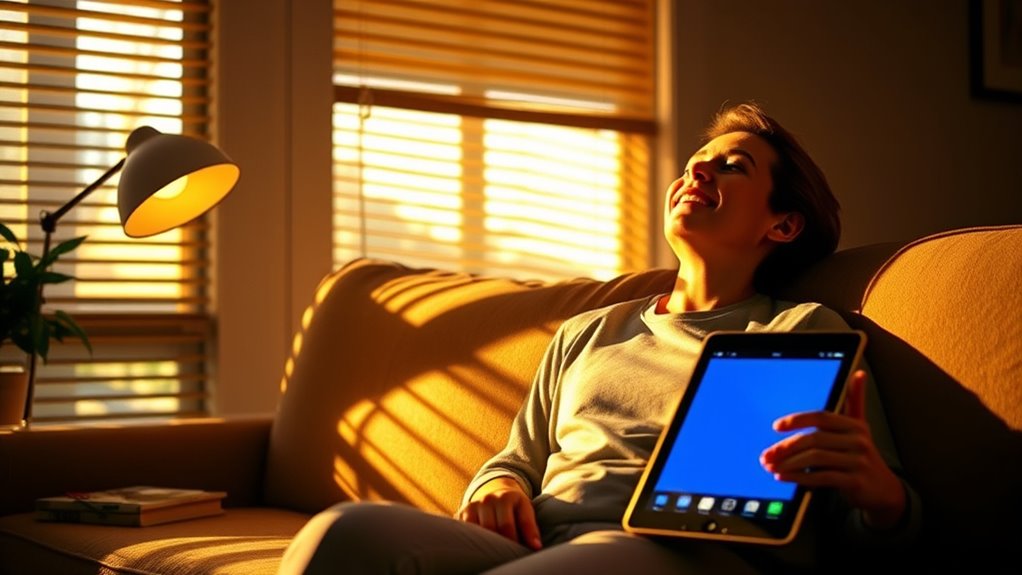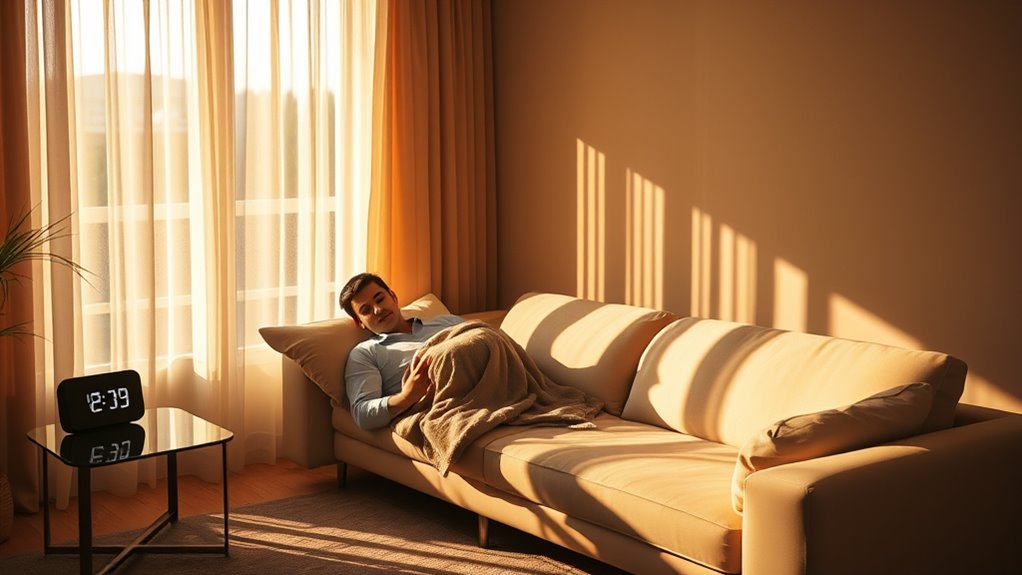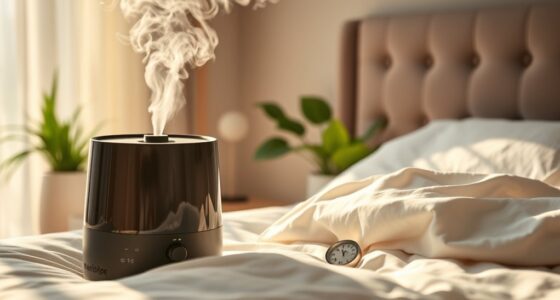To beat social jet lag at home, focus on strategic light exposure to reset your internal clock. Get sunlight early in the day to signal wakefulness and avoid bright screens and artificial lights in the evening, which can delay your sleep schedule. Creating a consistent routine and optimizing your sleep environment also helps. By making small adjustments to your light habits, you’ll find it easier to stay aligned with your daily schedule—exploring more ways can help you effectively manage your circadian rhythm.
Key Takeaways
- Get natural sunlight early in the day to reinforce your wakefulness and synchronize your internal clock.
- Limit screen time and bright lights in the evening to promote melatonin production and prepare for sleep.
- Use timed light therapy during mornings or afternoons to gradually shift your circadian rhythm.
- Maintain consistent sleep and wake times daily, including weekends, to strengthen your internal clock.
- Create a sleep-friendly environment that is dark, quiet, and cool to improve sleep quality and reduce social jet lag effects.

Even if you’re not traveling across time zones, you can still experience jet lag symptoms right at home. This phenomenon, often called social jet lag, occurs when your internal clock, or circadian rhythms, fall out of sync with your daily schedule. You might find yourself feeling tired during the day and wide awake at night, despite getting enough sleep. The good news is that you can take control by adjusting your exposure to light and improving your sleep hygiene. These tweaks help your brain reset your internal clock, aligning it more closely with your routine and reducing those disruptive feelings of fatigue and grogginess.
Your circadian rhythms are sensitive to light, which acts as a natural cue telling your body when to wake up and when to wind down. If your exposure to light isn’t aligned with your daily schedule—say you stay indoors all day or use screens late into the night—your internal clock can become desynchronized. This misalignment is what causes social jet lag, leaving you feeling sluggish or overly alert at odd hours. To combat this, try to get sunlight early in the day. Natural light helps reinforce your body’s internal schedule, signaling that it’s time to be awake. Conversely, in the evening, dim the lights and avoid screens to promote melatonin production, which encourages sleep.
Improving your sleep hygiene is equally essential. Establish a consistent sleep schedule, even on weekends, to help your circadian rhythms maintain a steady rhythm. Going to bed and waking up at the same times trains your body to anticipate sleep and wakefulness, minimizing the feeling of jet lag. Create a relaxing bedtime routine—think of reading a book or taking a warm bath—to cue your body that it’s time to wind down. Keep your sleeping environment cool, dark, and quiet, as these conditions support quality sleep and help your internal clock stay aligned. Incorporating light exposure at strategic times can further enhance your efforts to reset your internal clock effectively.
Also, be mindful of your evening activities. Avoid caffeine and heavy meals close to bedtime, as these can disrupt your sleep hygiene and throw off your circadian rhythms further. If you’re struggling to fall asleep, consider using light therapy or carefully timed light exposure to shift your internal clock gradually. By syncing your light exposure with your natural sleep-wake cycle and reinforcing good sleep habits, you can reduce social jet lag and feel more energized throughout the day. It’s all about listening to your body’s signals and giving it the cues it needs to stay on track, even without crossing time zones.
Frequently Asked Questions
Can Light Hacks Fully Eliminate Social Jet Lag?
Light hacks can markedly help with social jet lag, but they might not fully eliminate it. By adjusting your light exposure, you promote better circadian alignment, making it easier to sync your internal clock with your social schedule. However, individual differences and habits can influence outcomes. Consistent light exposure at strategic times can improve your sleep and alertness, but complete elimination of social jet lag may require additional lifestyle adjustments.
Are There Risks Associated With Using Light Therapy at Home?
Using light therapy at home is like walking a tightrope—you need balance. While it can help reset your internal clock, there are potential risks, such as eye strain, headaches, or disrupted sleep if misused. Always follow guidelines and consult a healthcare professional before starting light therapy. Proper use minimizes risks, ensuring you get the benefits without unintended side effects.
How Quickly Can Light Hacks Improve My Sleep Patterns?
Light hacks can start improving your sleep schedule within a few days, but significant circadian adjustment may take a week or more. By strategically exposing yourself to bright light in the morning or evening, you help reset your internal clock. Consistency is key, so stick to a routine. With patience and proper timing, you’ll notice better sleep patterns and increased alertness as your circadian rhythm aligns more closely with your desired schedule.
Is There an Ideal Time of Day to Use Light Therapy?
The ideal timing for light therapy depends on your goals. If you want to advance your sleep schedule, morning exposure is best, as it helps reset your internal clock. For delaying sleep, evening light works better. You should use light therapy consistently at the same time each day, ideally in the early morning, to maximize benefits and improve your sleep patterns effectively.
Can Light Tricks Help With Seasonal Affective Disorder?
Imagine waking up feeling more energized on gloomy mornings—that’s what light tricks can do for seasonal affective disorder (SAD). By strategically timing light exposure, you help reset your circadian rhythm, improving mood and alertness. Regular, morning light exposure can boost serotonin levels, combatting depressive symptoms. These simple light hacks harness your body’s natural clock, making a noticeable difference in managing SAD symptoms effectively.
Conclusion
So, who knew? The secret to avoiding jet lag isn’t booking another flight or sinking into endless naps. Turns out, a little strategic light exposure can trick your body into sync without ever leaving home. Ironically, the best way to escape the chaos of social jet lag is simply to manipulate your environment—no passport required. Next time you feel out of sync, just remember: the real travel hack might be right in your own living room.









